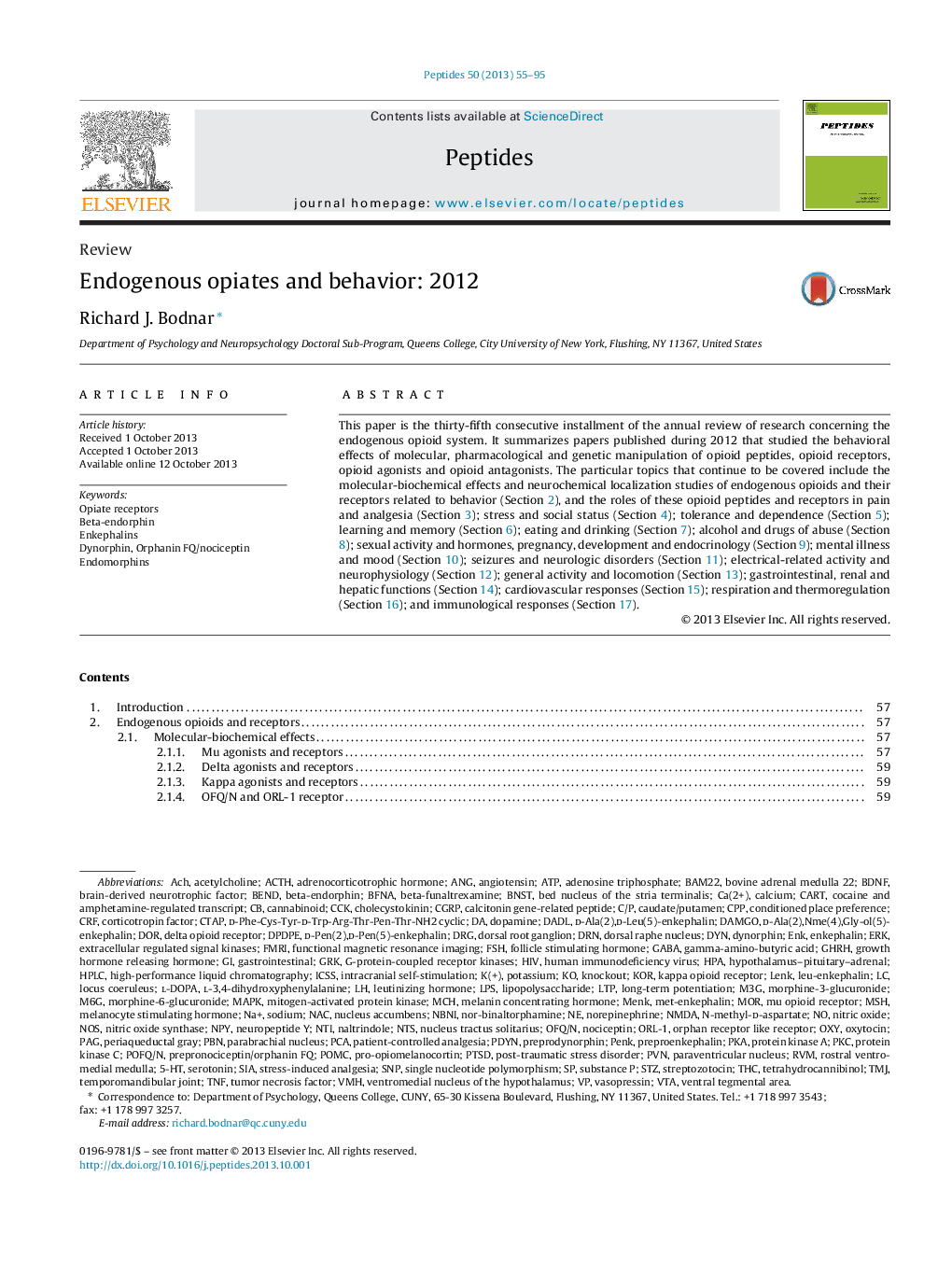| Article ID | Journal | Published Year | Pages | File Type |
|---|---|---|---|---|
| 2006157 | Peptides | 2013 | 41 Pages |
Abstract
This paper is the thirty-fifth consecutive installment of the annual review of research concerning the endogenous opioid system. It summarizes papers published during 2012 that studied the behavioral effects of molecular, pharmacological and genetic manipulation of opioid peptides, opioid receptors, opioid agonists and opioid antagonists. The particular topics that continue to be covered include the molecular-biochemical effects and neurochemical localization studies of endogenous opioids and their receptors related to behavior (Section 2), and the roles of these opioid peptides and receptors in pain and analgesia (Section 3); stress and social status (Section 4); tolerance and dependence (Section 5); learning and memory (Section 6); eating and drinking (Section 7); alcohol and drugs of abuse (Section 8); sexual activity and hormones, pregnancy, development and endocrinology (Section 9); mental illness and mood (Section 10); seizures and neurologic disorders (Section 11); electrical-related activity and neurophysiology (Section 12); general activity and locomotion (Section 13); gastrointestinal, renal and hepatic functions (Section 14); cardiovascular responses (Section 15); respiration and thermoregulation (Section 16); and immunological responses (Section 17).
Keywords
5-HTLPSDRGCPPTHCMORNACERKNOSNPYPOMCM3GCRFpKaGHRHCCKCGRPNMDAN-methyl-d-aspartatePAGSTZVTADRNICSSTMJNTSpDynPKCBNSTCARTRVMMCHpro-opiomelanocortinVMHGRKMet-enkephalinEnkephalinsCTAPSIAnociceptinNTIMSHMENKC/PPBNDPDPEM6GCaudate/putamenBAM22ORL-1G-protein-coupled receptor kinasesACTHTNFnBNIOFQ/NDADLdorsal root ganglionBDNFDAMGOl-3,4-dihydroxyphenylalaninel-DOPAMAPKNa+PCAAdenosine TriphosphateATPNaltrindoleangiotensinAChpost-traumatic stress disorderPTSDstreptozotocinAcetylcholineEndomorphinsEnkenkephalinOXYoxytocinAngBeta-endorphinBeta-funaltrexaminestress-induced analgesiaconditioned place preferencefMRIfunctional magnetic resonance imaginglong-term potentiationLTPBFNAperiaqueductal graybendIntracranial self-stimulationDORpatient-controlled analgesiaGastrointestinalDopaminedynorphinrostral ventromedial medullaSodiumSerotoninBrain-derived neurotrophic factortumor necrosis factorLeu-enkephalinLenklocus coeruleuslipopolysaccharideSubstance PPVNDyntemporomandibular jointMorphine-3-glucuronideMorphine-6-glucuronideHPAventral tegmental areaknockoutNor-binaltorphaminenorepinephrineNitric oxidenitric oxide synthaseNucleus accumbensparabrachial nucleusVentromedial nucleus of the hypothalamusbed nucleus of the stria terminalisnucleus tractus solitariusdorsal raphe nucleusparaventricular nucleusadrenocorticotrophic hormonegrowth hormone releasing hormonemelanocyte stimulating hormonefollicle stimulating hormoneMelanin concentrating hormoneFSHleutinizing hormonehypothalamus–pituitary–adrenalvasopressinKORHIVhuman immunodeficiency virusPotassiumprotein kinase AProtein kinase Cmitogen-activated protein kinasePreproenkephalinSingle nucleotide polymorphismcalcitonin gene-related peptidePreprodynorphinPENKSNPCannabinoidHPLChigh-performance liquid chromatographyCalciumcholecystokininCocaine and amphetamine-regulated transcriptGABAgamma-amino-butyric acidkappa opioid receptorMu opioid receptordelta opioid receptorOpiate receptorsNeuropeptide Y
Related Topics
Life Sciences
Biochemistry, Genetics and Molecular Biology
Biochemistry
Authors
Richard J. Bodnar,
